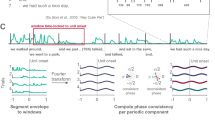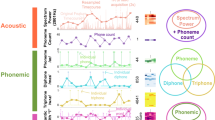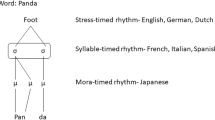Abstract
Speech segmentation, determining where one word ends and the next begins in continuous speech, is necessary for auditory language processing. However, because there are few direct indices of this fast, automatic process, it has been difficult to study. We recorded event-related brain potentials (ERPs) while adult humans listened to six pronounceable nonwords presented as continuous speech and compared the responses to nonword onsets before and after participants learned the nonsense words. In subjects showing the greatest behavioral evidence of word learning, word onsets elicited a larger N100 after than before training. Thus N100 amplitude indexes speech segmentation even for recently learned words without any acoustic segmentation cues. The timing and distribution of these results suggest specific processes that may be central to speech segmentation.
This is a preview of subscription content, access via your institution
Access options
Subscribe to this journal
Receive 12 print issues and online access
$209.00 per year
only $17.42 per issue
Buy this article
- Purchase on Springer Link
- Instant access to full article PDF
Prices may be subject to local taxes which are calculated during checkout



Similar content being viewed by others
References
Cutler, A. & Butterfield, S. Rhythmic cues to speech segmentation: evidence from juncture misperception. J. Speech Lang. Hear. Res. 31, 218–236 (1992).
Saffran, J.R., Newport, E.L. & Aslin, R.N. Word segmentation: the role of distributional cues. J. Mem. Lang. 35, 606–621 (1996).
Sanders, L.D. & Neville, H.J., Lexical, syntactic, and stress-pattern cues for speech segmentation. J. Speech Lang. Hear. Res. 43, 1301–1321 (2000).
Jusczyk, P.W. Infants' detection of the sound patterns of words in fluent speech. Cogn. Psychol. 29, 1–23 (1995).
Saffran, J.R., Aslin, R.N. & Newport, E.L. Statistical learning by 8-month-old infants. Science 274, 1926–1928 (1996).
Cutler, A., Mehler, J., Norris, D. & Segui, J. Limits on bilingualism. Nature 340, 229–230 (1989).
Sanders, L.D., Neville, H.J. & Woldorff, M.G. Speech segmentation by native and non-native speakers: the use of lexical, syntactic, and stress-pattern cues. J. Speech Lang. Hear. Res. (in press).
Sanders, L.D. & Neville, H.J. An ERP study of continuous speech processing: segmentation, semantics, and syntax in native speakers. Cogn. Brain Res. (in press).
Hansen, J.C. & Hillyard, S.A. Endogenous brain potentials associated with selective auditory attention. Electroencephalogr. Clin. Neurophysiol., 49, 277–290 (1980).
Hink, R.F., Hillyard, S.A. & Benson, P.J. Event-related brain potentials and selective attention to acoustic and phonetic cues. Biolog. Psychol. 6, 1–16 (1978).
McCandliss, B.D., Posner, M.I. & Givón, T. Brain plasticity in learning visual words. Cogn. Psychol. 33, 88–110 (1997).
Chwilla, D.J., Brown, C.M. & Hagoort, P. The N400 as a function of the level of processing. Psychophysiology 32, 274–285 (1995).
Holcomb, P.J. & Neville, H.J. Auditory and visual semantic priming in lexical decision: a comparison using event-related brain potentials. Lang. Cogn. Processes 5, 281–312 (1990).
Sanders, L.D. & Neville, H.J. An ERP study of continuous speech processing: segmentation, semantics, and syntax in non-native speakers. Cogn. Brain Res. (in press).
Acknowledgements
We thank R. N. Aslin for help with the stimuli, Y. Yamada for help with data acquisition, P. Compton and R. Vukcevich for technical support, and D. Coch, S. Guion, D. Poeppel, M. Posner, M. Spezio and D. Tucker for comments on previous drafts. Supported by the National Institute on Deafness and Other Communication Disorders (NIH grants DC00128, DC00481 and DC00167) and by the National Institute of General Medical Sciences (Institutional NRSA 5-T32-GM07257).
Author information
Authors and Affiliations
Corresponding author
Ethics declarations
Competing interests
The authors declare no competing financial interests.
Rights and permissions
About this article
Cite this article
Sanders, L., Newport, E. & Neville, H. Segmenting nonsense: an event-related potential index of perceived onsets in continuous speech. Nat Neurosci 5, 700–703 (2002). https://doi.org/10.1038/nn873
Received:
Accepted:
Published:
Issue Date:
DOI: https://doi.org/10.1038/nn873
This article is cited by
-
Biochar and exogenous calcium assisted alleviation of Pb phytotoxicity in water spinach (Ipomoea aquatica Forsk) cultivated in Pb-spiked soil
Environmental Geochemistry and Health (2022)
-
Neurocognitive Correlates of Statistical Learning of Orthographic–Semantic Connections in Chinese Adult Learners
Neuroscience Bulletin (2020)
-
Word meaning acquisition is reflected in brain potentials of isolated words
Scientific Reports (2017)
-
Auditory Magnetoencephalographic Frequency-Tagged Responses Mirror the Ongoing Segmentation Processes Underlying Statistical Learning
Brain Topography (2017)
-
Cortical tracking of hierarchical linguistic structures in connected speech
Nature Neuroscience (2016)



